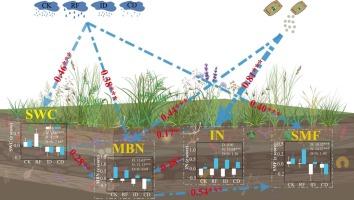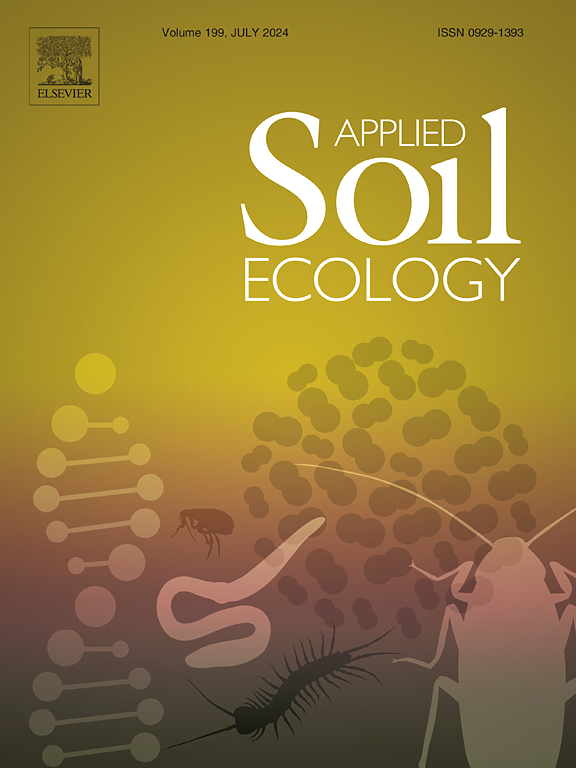增施氮肥可减轻降水量减少对典型草原土壤多功能性的负面影响
IF 4.8
2区 农林科学
Q1 SOIL SCIENCE
引用次数: 0
摘要
干旱事件和氮沉降日益频繁,从根本上改变了陆地生态系统的土壤微生物功能。然而,大多数研究主要集中于单一环境因素对生态系统功能的影响,干旱和氮富集如何交互影响土壤的多功能性在很大程度上仍是未知数。本研究在中国北方典型草原上进行了一项田间操作实验,实验的第四年考察了不同干旱情景(强干旱(ID)、慢性干旱(CD)和降雨频率降低(RF))和氮素添加对土壤微生物生物量和土壤多功能性(利用土壤酶活性测定)的影响。结果表明,ID 和 CD 均显著降低了土壤多功能性、微生物生物量碳(MBC)和微生物生物量氮(MBN)。CD 处理还降低了 MBC 与 MBN 之比,而 RF 对土壤多功能性和土壤微生物生物量的影响较小。相比之下,氮添加增强了土壤多功能性、MBC 和 MBN。结构方程建模分析表明,干旱直接和间接地通过降低土壤多功能性和土壤含水量来降低土壤多功能性,而氮素添加主要通过增加土壤多功能性和土壤无机氮来提高土壤多功能性。这项研究首次通过实验证明了降水量减少和氮素富集对半干旱典型草原土壤微生物生物量和土壤多功能性的相反影响,并表明氮肥施用可能是缓解气候干旱对氮和水有限的草原生态系统土壤功能负面影响的有效措施。本文章由计算机程序翻译,如有差异,请以英文原文为准。

Nitrogen addition alleviates the negative effects of reduction in precipitation on soil multifunctionality in a typical steppe
The increasing frequency of drought events and nitrogen deposition have fundamentally changed soil microbial functions in terrestrial ecosystems. However, most studies have mainly concentrated on the impact of a single environmental factor on ecosystem functions; how drought and nitrogen enrichment interactively affect soil multifunctionality remains largely unknown. In this study, the effects of different drought scenarios [intense drought (ID), chronic drought (CD), and reduced rainfall frequency (RF)] and nitrogen addition on soil microbial biomass, and soil multifunctionality (determined using soil enzyme activity) were examined in the fourth year of a field manipulative experiment conducted in a typical steppe in northern China. The results demonstrated that both ID and CD significantly reduced soil multifunctionality, microbial biomass carbon (MBC) and microbial biomass nitrogen (MBN). The CD treatment also decreased the ratio of MBC to MBN, while RF had less impacts on soil multifunctionality and the biomass of soil microbes. In contrast, nitrogen addition enhanced soil multifunctionality, MBC and MBN. Structural equation modeling analysis demonstrated that drought decreased soil multifunctionality directly and indirectly by reducing MBN and soil water content, whereas nitrogen addition increased soil multifunctionality mainly by increasing MBN and soil inorganic nitrogen. This study provides the first experimental evidence of the opposing impacts of reduction in precipitation and nitrogen enrichment on soil microbial biomass and soil multifunctionality in a semiarid typical steppe, and suggests that nitrogen fertilization could be an effective measure to alleviate the negative effects of climate drought on soil functions in nitrogen- and water-limited grassland ecosystems.
求助全文
通过发布文献求助,成功后即可免费获取论文全文。
去求助
来源期刊

Applied Soil Ecology
农林科学-土壤科学
CiteScore
9.70
自引率
4.20%
发文量
363
审稿时长
5.3 months
期刊介绍:
Applied Soil Ecology addresses the role of soil organisms and their interactions in relation to: sustainability and productivity, nutrient cycling and other soil processes, the maintenance of soil functions, the impact of human activities on soil ecosystems and bio(techno)logical control of soil-inhabiting pests, diseases and weeds.
 求助内容:
求助内容: 应助结果提醒方式:
应助结果提醒方式:


